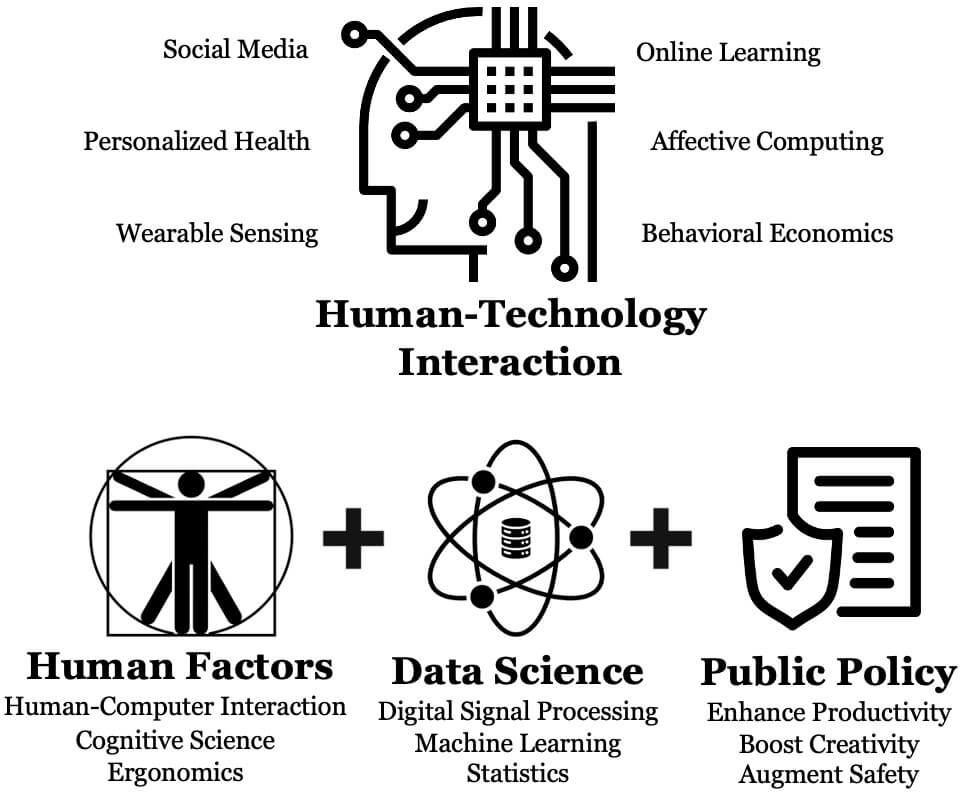
Human-Technology Interaction (HTI) Lab
Mission Statement
Investigate and model human-technology interaction to improve cognitive well-being, develop cost-effective wearable solutions, and provide policy recommendations to enhance human safety, productivity, and creativity.
Investigate and model human-technology interaction to improve cognitive well-being, develop cost-effective wearable solutions, and provide policy recommendations to enhance human safety, productivity, and creativity.
Vision
The Human-Technology Interaction (HTI) Lab at Plaksha University is dedicated to investigating human-technology interaction and enhancing human cognitive well-being by taking a multi-modal sensory approach. Our approach will involve the use of bio-sensors, computer vision, and electro-mechanical sensors to detect and model changes in human physiological and behavioral responses (such as but not limited to neural activity, facial expressions, heart-rate variability, pupillometry, and galvanic skin response), human ergonomics, and human cognition.
By integrating domain-specific knowledge from the fields of human factors, data science, and public policy, we will utilize human physiology and behavior to model the interaction between humans and technology.
Our interdisciplinary approach will provide insights into the complex interplay between technology and human cognition. These strategies will result in enhanced safety, productivity, and creativity for individuals in their environments. Our research findings will be aimed at contributing to the academic understanding of human-technology interaction and its impact on human behavior. Additionally, our research and recommendations shall have practical applications in the technology industry for the development of safer and more user-centered designs that promote cognitive well-being.
The Human-Technology Interaction (HTI) Lab at Plaksha University is dedicated to investigating human-technology interaction and enhancing human cognitive well-being by taking a multi-modal sensory approach. Our approach will involve the use of bio-sensors, computer vision, and electro-mechanical sensors to detect and model changes in human physiological and behavioral responses (such as but not limited to neural activity, facial expressions, heart-rate variability, pupillometry, and galvanic skin response), human ergonomics, and human cognition.
By integrating domain-specific knowledge from the fields of human factors, data science, and public policy, we will utilize human physiology and behavior to model the interaction between humans and technology.
Our interdisciplinary approach will provide insights into the complex interplay between technology and human cognition. These strategies will result in enhanced safety, productivity, and creativity for individuals in their environments. Our research findings will be aimed at contributing to the academic understanding of human-technology interaction and its impact on human behavior. Additionally, our research and recommendations shall have practical applications in the technology industry for the development of safer and more user-centered designs that promote cognitive well-being.
Ongoing Projects
• Monitoring Emotions and Cognitive Well-being through physiological responses in the real-world through a wrist wearable.
• Using wearables and computer vision to monitor human safety in industrial and driving environments to mitigate untoward incidents.
• Tracking productivity and creativity, and mitigating mental workload while users interact with technology.
• Utilizing computer vision towards generating a “real-like” human avatar for the Metaverse (with the ability to try on various wardrobe choices remotely).
• Monitoring Emotions and Cognitive Well-being through physiological responses in the real-world through a wrist wearable.
• Using wearables and computer vision to monitor human safety in industrial and driving environments to mitigate untoward incidents.
• Tracking productivity and creativity, and mitigating mental workload while users interact with technology.
• Utilizing computer vision towards generating a “real-like” human avatar for the Metaverse (with the ability to try on various wardrobe choices remotely).
Prospective Students
I am actively looking for motivated students to work on the above projects (or other ideas as well). If you are interested in joining my research group at Plaksha University in any role or would like to collaborate, please send me a note at siddharth.s[at]plaksha.edu.in
I am actively looking for motivated students to work on the above projects (or other ideas as well). If you are interested in joining my research group at Plaksha University in any role or would like to collaborate, please send me a note at siddharth.s[at]plaksha.edu.in
Courses
I am presently teaching Machine Learning and Pattern Recognition course at Plaksha. To check out the course webpage and the terrific real-world projects my students are working on, please click here.
I am presently teaching Machine Learning and Pattern Recognition course at Plaksha. To check out the course webpage and the terrific real-world projects my students are working on, please click here.